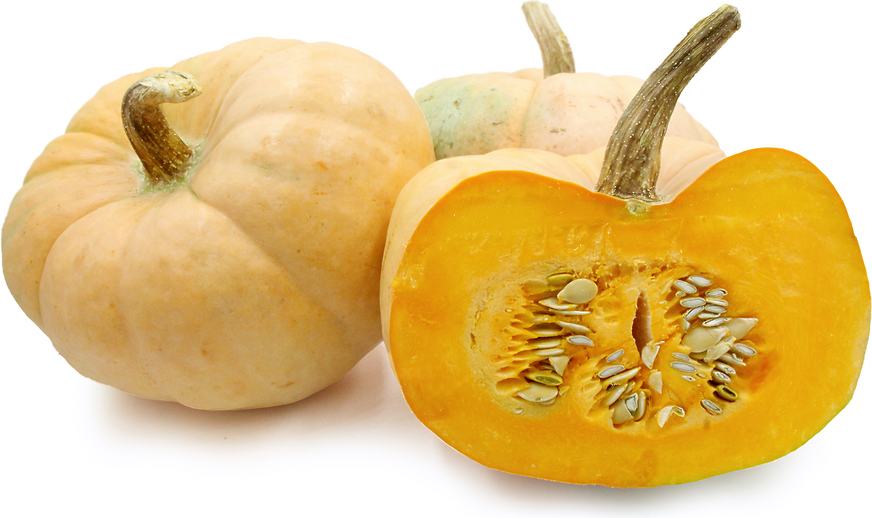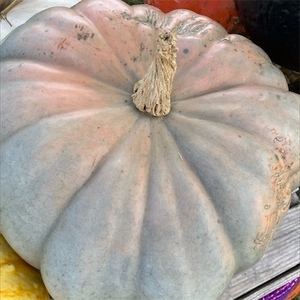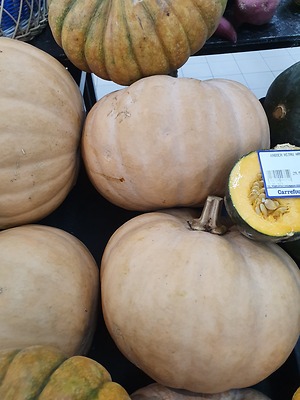


Porcelain Doll Pumpkin Squash
Estimated Inventory, lb : 0
Description/Taste
Porcelain Doll squash is medium to large in size, averaging 16-24 pounds, and is globular, blocky, and has a shallow, sunken in stem cap. The smooth rind is deeply ribbed and lobed and transforms from a pale yellow to cream and then pink when mature. There is also a sturdy stem that develops a cork-like texture when mature. The thick flesh is orange and surrounds a central cavity that contains some pulp and many flat, tear-drop shaped, cream-colored seeds. When cooked, Porcelain Doll squash is tender with a smooth texture and a sweet flavor.
Seasons/Availability
Porcelain Doll squash is available in the fall.
Current Facts
Porcelain Doll squash, botanically classified as Cucurbita maxima, grows on a long vining plant and is a member of the Cucurbitaceae family along with pumpkins and gourds. Also known as the Pink pumpkin, this squash is an intentional proprietary hybrid created by a DP seeds, a company specializing in hybrid development. Porcelain Doll squash is favored for its sweet flavor, tolerance to powdery mildew, and unusual color. After seeing the striking pink color of the new squash variety, the company's president also decided it was the perfect candidate for fundraising efforts during October for breast cancer awareness.
Nutritional Value
Porcelain Doll squash is a good source of vitamin A, vitamin C, and iron. The large squash variety also contains a small amount of calcium.
Applications
Porcelain Doll squash is best suited for cooked applications such as roasting, baking, sautéing, and boiling. It can be roasted to make soups, casseroles, and stews or pureed for baked goods such as cheesecake, cupcakes, pies, tarts, muffins, and other desserts. It can also be cooked and used for canning, gnocchi, pasta, ravioli, bisques, hummus, and lattes. In addition to the flesh, the seeds are also edible and can be roasted and salted as a snack. Porcelain Doll squash pairs well with onions, garlic, shallots, black beans, red kale, zucchini, quinoa, rice, green beans, spices and herbs such as cinnamon, yellow curry powder, hatch chile powder, rosemary, sage, and thyme, potatoes, coconut milk, peanut butter, sunflower seeds, and roasted peanuts. It will keep up to one month when stored whole and unwashed in a cool and dry place. If refrigerated, it will store up to three months.
Ethnic/Cultural Info
The pink color of Porcelain Doll squash is not only eye-catching, but it has also become the symbol for a cause. Porcelain Doll squash is being marketed as the perfect item for fundraising activities during October as it is also breast cancer awareness month. Growers pledge to donate a percentage of their profits to the Pink Pumpkin Patch Foundation. This nonprofit organization donates the money to breast cancer research through a vigorous vetting and grant application process. Since 2012, the foundation has awarded almost $100,000 in grants to cancer research.
Geography/History
The Porcelain Doll squash was developed by DP Seeds in Yuma, Arizona and was released in the United States in 2011, with the intention of having it debut in the fall of 2012. Today Porcelain Doll squash are available in limited quantities through farmers markets, online seed catalogs, and specialty grocers in the United States.
Recipe Ideas
Recipes that include Porcelain Doll Pumpkin Squash. One
| Garden Betty |
|
Homemade Pumpkin Puree |










